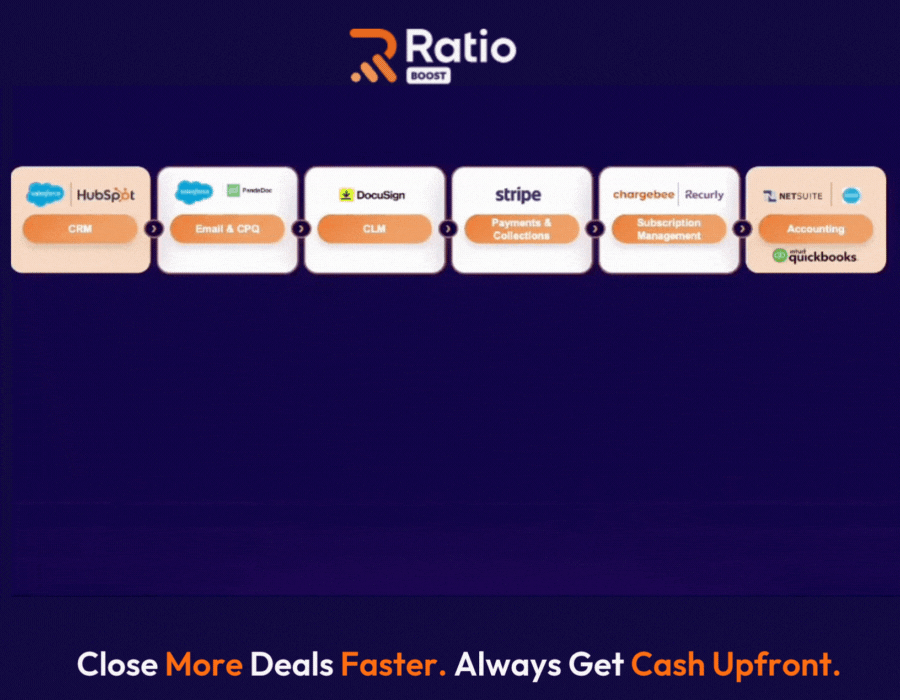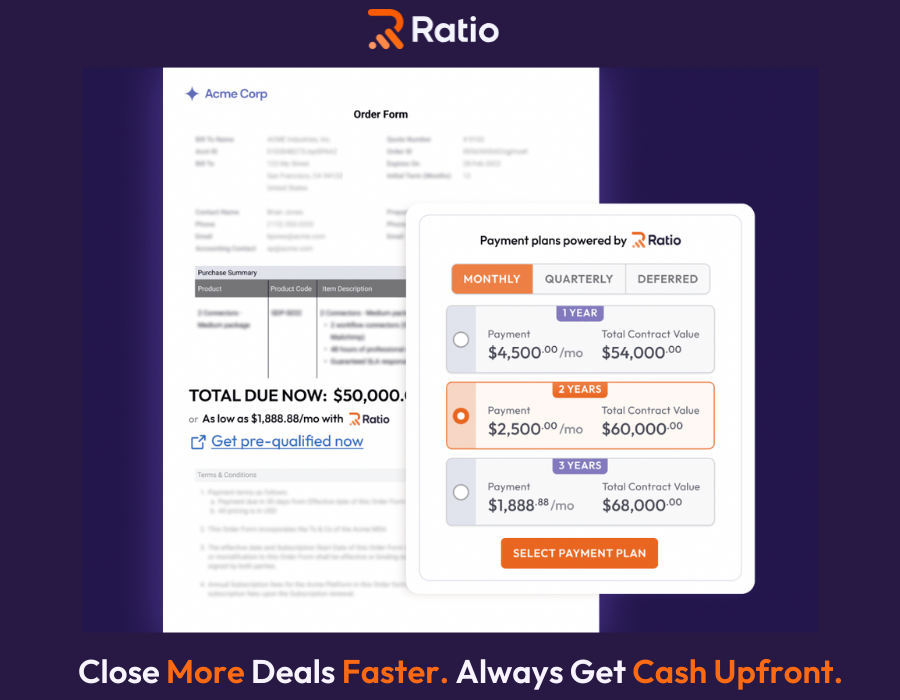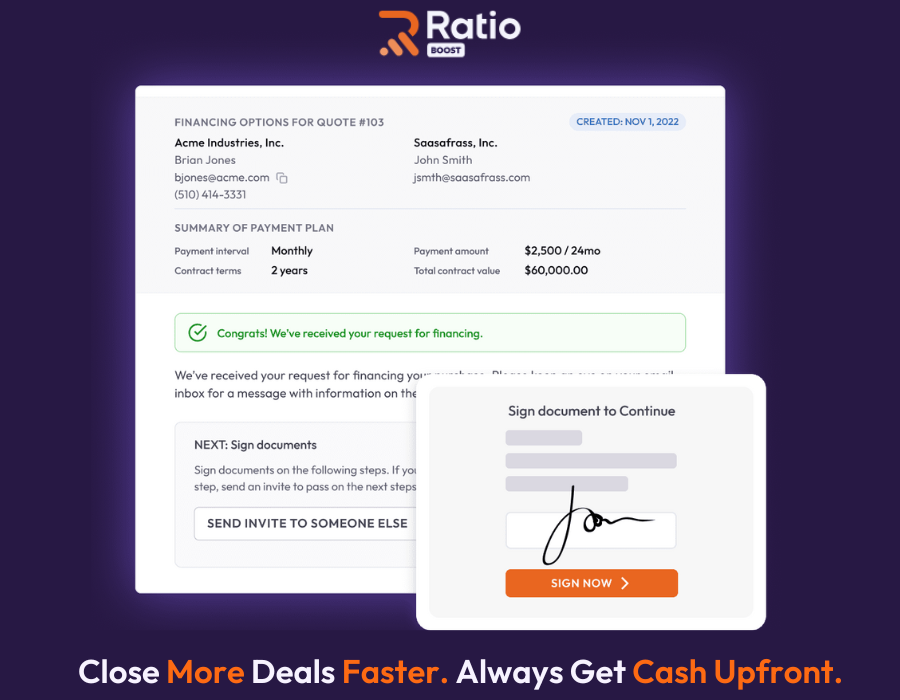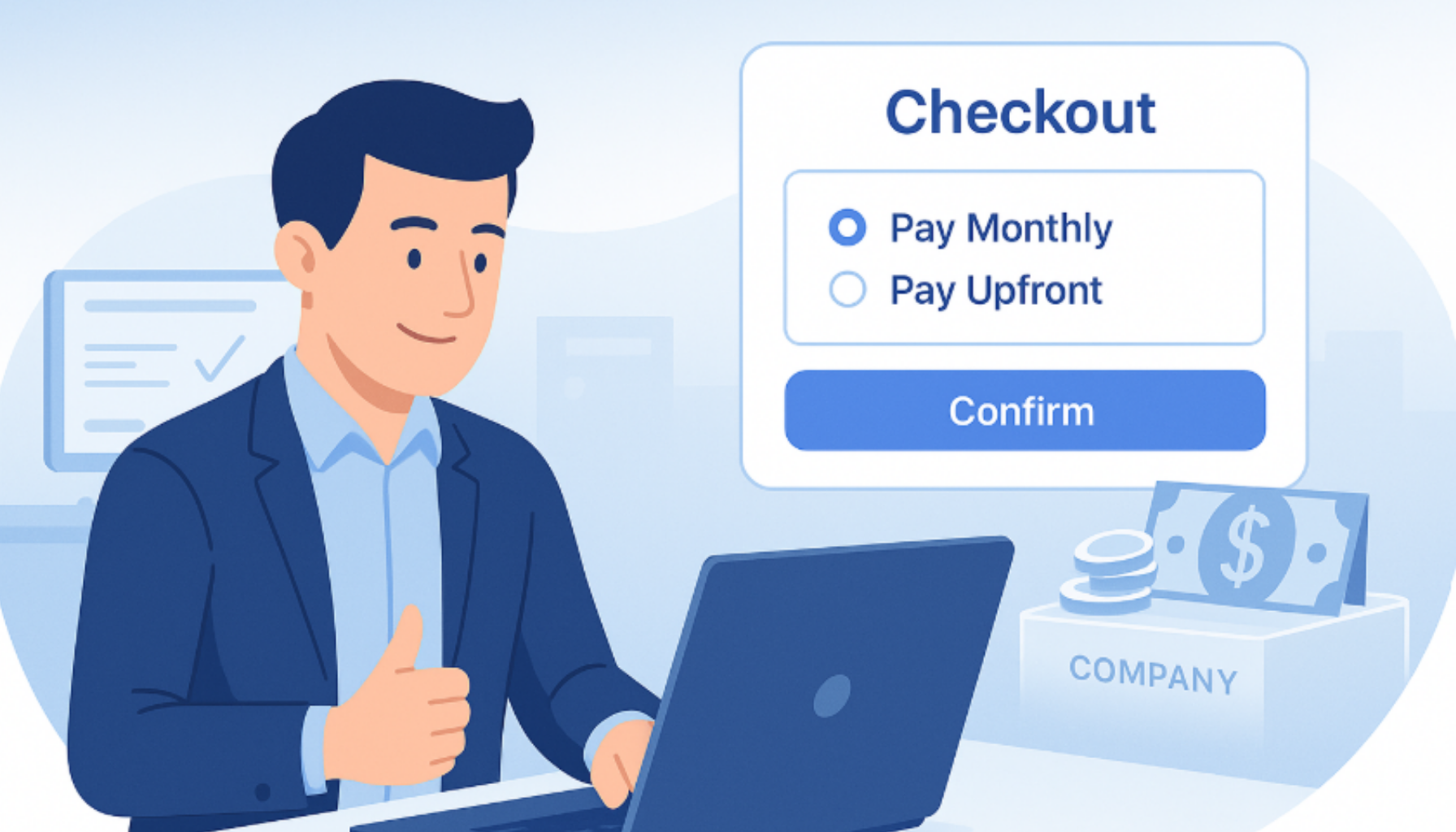5 B2B Collections Best Practices Every SaaS Company Needs to Implement Now
| TL;DR - Every missed follow-up, delayed payment, or manual invoice adds friction—and risk—to your revenue. This post breaks down five best-in-class practices B2B SaaS companies should implement to modernize B2B collections, reduce Days Sales Outstanding (DSO), and protect revenue continuity. You’ll also see how Ratio’s B2B Collections capabilities make the best practices easy to adapt. |
🚨 The Challenge: You close the deal—but cash doesn’t follow.
Revenue gets booked, but collecting it happens later—often manually, with no clear owner. As volume grows, so do aging invoices, missed follow-ups, and stalled cash flow.
This isn’t just inefficient—it’s expensive. A 2025 benchmark found that 22.2% of fast-growing SaaS companies lose over 10% of ARR to late payments and defaults—not churn, but customers under contract.
That gap between revenue and realization isn’t just a finance issue. It’s a growth constraint.
❌ Accounts Receivable (AR) builds silently
❌ Forecasts slip
❌ Teams chase what’s already sold
So think about it:
📉 How much ARR are you losing to process, not product?
📈 What if collections ran like sales—automated, structured, and built to scale?
That’s the shift underway. Here are five B2B collections practices making it real—plus how Ratio simplifies each one.
Let’s dive in 🤿
Five B2B Collections Best Practices for SaaS and How Ratio Powers Each One
Collections isn’t just about getting paid; it's about protecting your ability to operate, grow, and compete. And in B2B, it’s not like B2C: you’re not chasing card payments—you’re navigating high-stakes contracts, multiple stakeholders, and long-tail cash cycles.
That’s why modern SaaS leaders are rethinking collections as a core revenue function—not a back-office chore.
Here are five best practices for B2B collections shaping how they’re closing the gap between bookings and cash—with smarter systems, faster signals, and better execution:
- Structure Deals Upfront Based on Buyer Risk and Intent
- Turn Invoicing into a Real-Time Checkout and Activation Layer
- Automate Collections Flows Based on Buyer Behavior and Risk Tier
- Equip Go-To-Market (GTM) and Customer Experience (CX) Teams with Real-Time Collections Visibility
- Use Collections Data to Inform Pricing, GTM, and Qualification Strategy
Let’s unpack each one.
1. Structure Deals Upfront Based on Buyer Risk and Intent
✅Best Practice
Don’t wait for collections to fix cash gaps—solve them at the quote stage.
Smart SaaS teams assess each buyer’s financial profile and intent signals before the deal closes, then match payment terms accordingly: upfront, low-interest installments, or extended plans.
The outcome? Fewer payment delays. Fewer defaults. And a much faster path from bookings to cash.
💡Why It Matters
In B2B SaaS, payment failure isn’t usually about unwillingness—it’s about misalignment.
- Startups or SMEs may be eager to buy but can’t pay large invoices upfront.
- Large Enterprises often have the budget—but procurement cycles that stretch 60+ days.
Yet most SaaS companies still apply one-size-fits-all terms like Net 30—and hope for the best.
📊 According to Atradius, 55% of all B2B invoiced sales are overdue, and 9% are written off entirely as bad debt.
Much of this stems from contract terms that don’t reflect how—and when—buyers can realistically pay.
That’s why leading teams are shifting left—using deal structure as a strategic lever to secure cash earlier and reduce downstream friction.
⚙️Ratio Advantage
Ratio helps you structure smarter, faster, and without adding operational burden with:
- 🔍 Real-Time Buyer Scoring: Ratio surfaces risk signals like credit score, historical payment behavior—directly within the quoting process.

- 💳 Term Matching Logic: Based on the buyer’s profile, you can offer relevant options—upfront, 0%-interest over 6 months, or extended plans—without slowing down the deal.
- 🛡️ Risk Offload Built In: Once terms are accepted, Ratio takes on credit and payment risk—so if the buyer defaults or delays, it doesn’t hit your balance sheet.
- 🔄 Integrated into Quote-to-Cash (Q2C): All of this flows inside your quote-to-cash motion. No external financing tools or broken handoffs.

💰 Bonus: Get Paid Upfront Anyway
Even if a buyer pays over time as per their terms, Ratio Boost pays you up to 96% of the Annual Contract Value (ACV) on day one. You choose how to handle the financing fee(~4%)—absorb it, split it with the buyer, or pass it all to the buyer.
You can learn more about it here.

Collections are one pillar, see five more ways SaaS leaders are future-proofing cash flow here!
2. Turn Invoicing into a Real-Time Checkout and Activation Layer
✅Best Practice
Replace static invoicing with an interactive, self-serve checkout flow the moment a deal closes. That means embedding payment selection, contract execution, and onboarding triggers into a single, frictionless experience—right at the point of intent.
💡Why It Matters
Most SaaS companies treat payment as something that happens after the deal closes—via PDF invoices, offline processing, or disjointed billing systems. That creates delays right when momentum is highest:
- Sales mark a deal “Closed Won.”
- Finance sends an invoice hours or days later
- The buyer is left to route approvals, figure out how to pay, or wait for procurement
🌪️ That gap introduces risk, kills urgency, and slows revenue recognition.
🗓️ Even a 3–5 day lag between sale and activation can compound into weeks of cash delays.
🏃🏻♀️ In some cases, it leads to abandonment before onboarding even begins.
Today’s buyers expect B2C-style clarity and speed—especially when they’re ready to move forward. Your collections system shouldn’t be the bottleneck.
⚙️Ratio Advantage
[Ratio Boost](https://www.ratiotech.com/boost) replaces slow, back-office invoicing with a checkout-grade experience designed for modern B2B SaaS—see Ratio Boost for SaaS for details:
- 🧾 Embedded Checkout Flow: Buyers receive a branded, interactive checkout page—pre-populated with their deal details and payment plan options.
- ✍️ Real-Time E-sign and Payment Capture: Buyers select how they want to pay (e.g., upfront, installment), sign, and submit—all in one place.

- 🔄 Immediate Activation: Once accepted, the system triggers downstream processes (e.g., provisioning, onboarding) automatically.
- 🧩 CRM and Billing Sync: Everything maps directly into your CRM and billing tools—no extra ops overhead or manual reconciliation.
It’s not just faster—it’s more buyer-friendly, more scalable, and more likely to convert intent into actual payment.
3. Automate Collections Flows Based on Buyer Behavior and Risk Tier
✅Best Practice
Move beyond static dunning cadences. Instead, automate your follow-up workflows based on how each buyer actually behaves—their payment track record, contract profile, and risk level. That means customizing collections by tier, not just timeline.
💡Why It Matters
Not every late payment is the same. Some buyers are forgetful. Others are habitual defaulters. Treating them the same—via generic email sequences—wastes time and risks revenue.
Without behavior-driven automation:
- You chase low-risk customers too aggressively
- You miss early signs of risk in higher-exposure accounts
- You burn cycles on accounts that were never recoverable
Modern SaaS companies use collections automation not just to recover cash but to preserve relationships and allocate team effort where it matters most.
⚙️Ratio Advantage
Ratio doesn’t just automate follow-ups—it adapts collections to each buyer’s real-world signals:
- 🧠 Behavior-Driven Sequencing: Ratio tracks how buyers engage post-sale—payment patterns, system usage, missed milestones—and adjusts communication style and cadence accordingly.
- 🧾 Smart Tiering: High-risk accounts are flagged for earlier intervention, while predictable payers get soft-touch, self-serve reminders.
- 🔔 Escalation Intelligence: Ratio triggers the right next step—automated reminder, sales assist, or legal notice—based on risk tier and contract terms.
- 📥 All in One Flow: Teams don’t need to stitch together CRM data, email tools, and finance logs. Ratio runs the playbook natively while surfacing key actions in your CRM.
This ensures your collections strategy is not just efficient—it’s precision-targeted, respectful, and revenue-aligned.
4. Equip GTM and CX Teams with Real-Time Collections Visibility
✅Best Practice
Make collections data accessible to more than just Finance. Give Sales, Customer Success, and RevOps teams real-time visibility into key AR metrics—like payment status, delinquency risk, and plan type—directly in the systems they already use.
💡Why It Matters
Collections don’t just affect the finance team. When a customer misses payments or delays a renewal, it impacts:
- CS teams trying to drive adoption or upsell
- Sales reps prepping for a renewal or expansion
- RevOps leaders forecasting pipeline and retention
But most SaaS companies silo collections data inside accounting or ERP tools—leaving GTM teams flying blind.
📉 This leads to awkward account conversations
📉 Missed signs of churn risk
📉 Misaligned GTM motions and lost revenue opportunities
When AR data is connected to your customer-facing teams, it becomes a proactive signal, not just a reactive report.
⚙️Ratio Advantage
Ratio brings collections intelligence into the tools your teams already work in:
- 📍 CRM-Embedded Collections Status: CSMs and AEs can see which customers are current, overdue, or under a payment plan—right in the account view.
- 🚩 Risk Flags and Alerts: Get notified when high-value accounts show early signs of payment issues—before it affects renewals or upsells.
- 📊 Collections Insights as GTM Signals: Track which plans, segments, or terms lead to late payments—so GTM teams can adjust strategy upstream.
- 🔁 Bi-Directional Sync: No more back-and-forth with Finance—Ratio keeps your CRM, billing, and collections data connected and consistent.
When everyone sees the same financial truth, you can act faster, align better, and protect more revenue.
5. Use Collections Data to Inform Pricing, GTM, and Qualification Strategy
✅Best Practice
Don’t just collect payments—collect insights. Use what your collections data reveals about buyer behavior, risk trends, and plan performance to refine how you price, qualify leads, and structure deals across your go-to-market motion.
💡Why It Matters
Collections data is a goldmine of GTM intelligence—but most SaaS companies fail to harness it.
- Which segments delay or default more often?
- Which payment terms or price points correlate with high DSO?
- Which sales reps consistently close deals with problematic recovery timelines?
📉 Without these insights, companies keep repeating the same mistakes—offering rigid payment terms to flexible buyers, underpricing high-risk segments, or qualifying deals with poor conversion to cash.
📊 Bain & Company notes that companies using AI and operational data to shape commercial strategy outperform peers in revenue growth and margin expansion.
Collections shouldn't just be a back-end function—it should actively inform how you sell, price, and scale.
⚙️Ratio Advantage
Ratio captures and connects collections data across your Q2C stack—then turns it into actionable inputs for GTM teams:
- 📈 Plan Performance Insights: Track repayment rates, delinquency, and DSO by term type, deal size, or buyer segment.
- 🎯 Lead Scoring & Qualification Feedback: Feed payment history and plan risk back into your CRM to improve ICP targeting and SDR prioritization.
- 🧮 Pricing Co-Pilot Data Sync: Use collections outcomes to refine your pricing strategy—flagging where to offer flexibility or tighten terms.
- 🔂 Closed-Loop Learning: Sales, Finance, and Product can iterate faster with visibility into what payment structures actually convert and collect.
With Ratio, collections doesn’t just recover revenue—it becomes a feedback engine that drives smarter, more resilient growth.
The five practices we’ve outlined aren’t theoretical—they’re proven moves already reshaping how top SaaS companies collect, protect, and grow revenue. But knowing what works is only half the battle. Execution is where most teams get stuck.
That’s where Ratio comes in—not just as a tool but as the embedded operating layer that makes these practices real, fast, and scalable.
Build a Modern B2B Collections Engine with Ratio
You’ve seen the playbook. Now, here’s how to put it into action.
Ratio isn’t just a tool—it’s an embedded collections engine that fits directly into your quote-to-cash stack. Fast to launch. Easy to manage. Built to drive revenue, not just recover it.
Here’s how leading SaaS teams are rolling it out—and how one SaaS provider did it in practice:
🔌Connect Ratio to Your Existing Stack
Ratio offers native integrations with your Q2C ecosystem:
- CRM (e.g., Salesforce, Hubspot): Pulls deal status, buyer profiles, account ownership
- Billing Platforms (e.g., Stripe, Chargebee): Syncs invoices, payment triggers with your current billing tool or replace it by Ratio's built-in system.
- Contract Tools (e.g., DocuSign, HelloSign): Coordinates activation and signature events leveraging your current signature system or replace it by Ratio's own built-in system.
No required system replacement—just if you want to. No data migration. Just a layer that connects across systems.
🧠 Configure Risk Scoring & Term Logic
Define how Ratio should auto-score buyer risk and recommend payment terms:
- Set rules by segment, company size, or funding stage
- Customize scoring models based on internal thresholds
- Create defaults for term offers (e.g., upfront, 6-month 0%, extended 12-month)
This ensures every deal routes through consistent, data-informed guardrails.
💳 Enable Embedded Checkout Flow
Once a deal hits Closed-Won, Ratio triggers a branded checkout experience:
- Buyer sees tailored term options, e-sign contract, and selects a payment method
- Payment and agreement are completed in a single, embedded flow
- Works across ACH, cards, net terms, or BNPL—no engineering required
🤖 Leverage Ratio's Collections Platform
Post-sale, Ratio monitors every account and handles follow-ups:
- Automates reminders based on due dates, risk signals, or usage patterns
- Escalates to your team only when needed (e.g., repeated delays, silent accounts)
- Learns and adapts to your customer behavior over time
📊 Customize Dashboards for GTM, Finance, and CS
Make collections data accessible to all stakeholders:
- Configure dashboards by team (e.g., DSO by rep for RevOps, delinquency by segment for Finance)
- Feed insights back into pricing, segmentation, and renewal playbooks
- Optionally, sync key repayment data into CRM so Account Managers (AMs) and Customer Success Managers (CSMs) have real-time visibility
Ratio is built to put B2B collections on autopilot. Most teams go live in just 7–10 business days—with no internal engineering required.
Implementation is fast, guided, and low-lift—supported by Ratio’s onboarding team and pre-built workflows that slot directly into your existing revenue motion.
Let us show you how Ratio transforms collections from a back-office task into a front-line growth lever. → Book a live demo now.
FAQs
- When Does it Make Sense to Involve a Third-Party Collections Agency?
Third-party agencies should be your last resort—not your day-to-day strategy. They often step in only after a customer has gone dark or is significantly delinquent, and they typically take 20–50% of what they recover. Worse, their involvement can strain your customer relationships.
That’s exactly what Ratio helps you avoid.
Unlike external agencies, Ratio operates inside your brand experience—automating collections as part of your quote-to-cash flow. The AI collections agent engages customers early, contextually, and on your terms—so you rarely need to escalate externally.
If your current process relies heavily on manual chasing or late-stage recovery, it’s time to bring collections in-house—with Ratio.
- Are There Risks in Offering Flexible Payment Terms to Reduce AR Friction?
Yes—if flexibility is offered blindly. Extending terms without understanding buyer risk can delay cash, increase defaults, and create operational drag.
But when flexibility is paired with data? It becomes a growth lever.
That’s what Ratio does. By scoring buyer risk and intent in real-time (e.g., funding stage, payment behavior), Ratio lets you offer tailored terms without compromising cash flow. As with Ratio Boost, you still get paid upfront.
So, the risk isn’t in being flexible. It’s in being uniform.
- How do we Measure Collections Success Beyond DSO?
DSO (Days Sales Outstanding) is useful—but it's just the start.
Modern SaaS leaders track:
- Cash conversion speed: From booking to cash-in-bank
- Plan-specific delinquency: Which term structures drive late payments
- Revenue risk exposure: ACV is at risk due to overdue balances
With Ratio, these metrics are surfaced in real-time—closing the loop between collections and GTM strategy.








.png)



